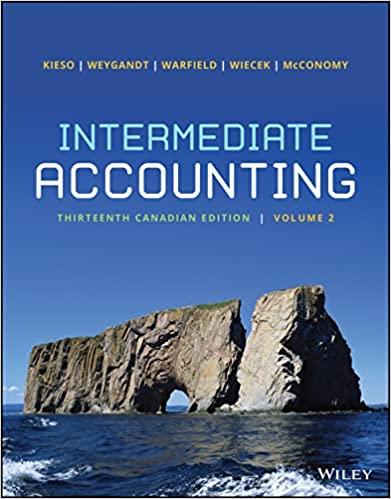The following are independent situations for Bramwell Corp. 1. Estimated warranty costs (covering a three-year warranty) are
Question:
The following are independent situations for Bramwell Corp.
1. Estimated warranty costs (covering a three-year warranty) are expensed for financial reporting purposes at the time of sale but deducted for income tax purposes when they are paid.
2. FV-NI equity investments have a quoted market value that is recorded at fair value through net income and is adjusted to their fair value at the SFP date.
3. The depreciation on equipment is different for book and income tax purposes because of different bases of carrying the asset, which was acquired in a trade-in. The different bases are a result of different rules that are used for book and tax purposes to calculate the cost of assets acquired in a trade-in.
4. A company properly uses the equity method to account for its 30% investment in another taxable Canadian corporation. The investee pays non-taxable dividends that are about 10% of its annual earnings.
5. Management determines that the net realizable value of the inventory is below cost, causing a writed own in the current year.
6. A company reports a contingent loss (ASPE) or provision (IFRS) that it expects will result from an ongoing lawsuit. The loss is not reported on the current year’s tax return. Half the loss is a penalty it expects to be charged by the courts. This portion of the loss is not a tax-deductible expenditure, even when it is paid.
7. The company uses the revaluation model for reporting its land and buildings. Due to current economic conditions, the fair value of the properties declined and the writedown was recorded against the revaluation surplus reported in equity.
8. The company settles its retirement obligation on a drilling platform that is put out of service. The actual settlement was less than the amount accrued, and the company recognizes a gain on settlement in its accounting net income.
Instructions
For each of the situations above:
a. Indicate whether it results in a reversing (timing) difference or a permanent difference in the year. Be sure to note any differences between ASPE and IFRS.
b. Discuss the nature of any deferred tax accounts that result from the situations in part (a), including their possible classifications in the company’s balance sheet. Indicate how these accounts should be reported. Note any differences between IFRS and the asset-liability method under ASPE.
Step by Step Answer:

Intermediate Accounting Volume 2
ISBN: 9781119740445
13th Canadian Edition
Authors: Donald E. Kieso, Jerry J. Weygandt, Terry D. Warfield, Irene M. Wiecek, Bruce J. McConomy





